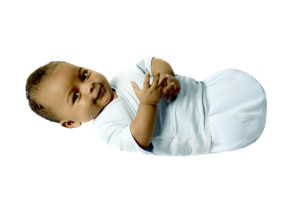]
Swaddling may have come back into fashion, particularly after speculation about how Prince George appeared to be wrapped as he left hospital. But the centuries-old practice could damage babies’ hips is the warning after the issue was highlighted by a British surgeon.
Professor Nicholas Clarke, an orthopaedic surgeon from Southampton University Hospital, argues that swaddling may damage the normal development of youngsters’ hips. He says that swaddling (tightly wrapping a baby) forces the hips into a straightened position where the legs are pressed together, which may lead to a condition called hip dysplasia. The condition is not always painful, but can cause joint abnormalities and result in long-term complications such as osteoarthritis if left untreated. Severe cases may eventually require hip replacement.
Professor Clarke does not describe whether there are current guidelines around the use of swaddling in the UK; however, the media has quoted advice from the Royal College of Midwives that says swaddling is not advised. If a parent does choose to swaddle their baby, tight swaddling that does not allow the baby’s hips and knees to move freely is generally not recommended. Care should also be taken to make sure that the baby does not get too hot.
What type of study is this?
This is not a piece of new research into the practice of swaddling and its association with hip dysplasia. It is an opinion piece written by one surgeon following his review of the evidence. It was published in the peer-reviewed journal Archives of Disease and Childhood.
The author bases his piece on previous research that is only briefly described. His methodology is not provided, so it is not possible to say whether all relevant evidence related to the use of swaddling has been considered. There is always the risk that the author may have cherry-picked the evidence that supports his argument, ignoring the opposing evidence. This is why the ideal approach to these types of questions is to carry out a systematic review.
What is swaddling and what are the perceived benefits?
Swaddling typically involves binding or bundling a baby in cloth or blankets with the lower limbs extended (straightened) and the arms restrained. According to Professor Clarke, swaddling is commonplace in some cultures, and approximately 90% of infants in North America are swaddled in the first few months of life. It is thought that the feeling of being held tightly within the cloth or blanket helps babies feel settled and aids sleep by recreating the restricted space of the mother’s womb.
The author reports there has been a recent return of swaddling because of its perceived effect on promoting sleep and the management of colic (the medical term for excessive and frequent crying in a baby who appears to be otherwise healthy). There are also unproven claims in the media that swaddling has become fashionable as it is apparently being used by the Duke and Duchess of Cambridge for Prince George, as well as by celebrities such as Kim Kardashian and Kanye West.
What potential harms does the author raise and what evidence are these based on?
The author describes how a 2007 systematic review and a 2013 review on the management of colic noted an association between swaddling and a condition called developmental dysplasia of the hip (DDH). DDH is a term used when talking about hip dysplasia in children.
Hip dysplasia means that the bones of the hip joint are not aligned correctly, which prevents the hip joint from functioning properly. According to the opinion piece, risk factors for DDH include breech delivery (bottom-first) and family history.
Professor Clarke says that ultrasounds have shown that approximately 20% of newborns have hip dysplasia or hip structure growth abnormalities. In most cases this resolves by itself, but he says these hips may be vulnerable to continuing dysplasia if not managed appropriately.
Professor Clarke describes that swaddling forces the hips into extension (a straightened position) and adduction (when the legs are pressed close together). This may interfere with the body’s ability to resolve any abnormalities naturally. This may then lead to a worsening of hip dysplasia that requires treatment. The Professor cites numerous other reports and international studies that looked at the relationship between swaddling and hip dysplasia.
The author states that under the new UK Newborn and Infant Examination protocol, infants identified as at risk for hip dysplasia will have a hip ultrasound when they are six weeks old. Those found to have dysplasia may be monitored or managed with a harness that keeps the baby’s knees bent (flexed) and out to the side (abducted) for a period of time and does not allow swaddling.
Professor Clarke says that healthcare professionals should determine if an infant with hip dysplasia is being swaddled and, if so, they should advise parents to stop swaddling or to “safe swaddle”. He says that “safe swaddling” with appropriate devices should be promoted, as it is recognised that traditional swaddling is a risk factor for developmental dysplasia of the hip (DDH).
The professor says that to allow for healthy hip development, legs should be able to bend up and out at the hips, allowing for natural development of the hip joints, and that babies’ legs should not be tightly wrapped in a straight position and pressed together. In discussing products for swaddling, he says these should have a loose pouch for the legs and feet, allowing plenty of hip movement.
Professor Clarke concludes by reporting that the International Hip Dysplasia Institute has issued a statement and emphasised the need for infant hips to be properly positioned to allow them to maintain the foetal posture during the first six months of life.
Conclusion
In summary, this is not new research into whether swaddling leads to hip dysplasia, which is what media reporting may lead you to believe. Rather, as the title of the piece describes, it is “an orthopaedic perspective”, written by one surgeon and based on previous research. However, as methodology is not provided, it is unclear whether all the evidence relating to the topic has been consulted.
While the decision to swaddle may be influenced by parents’ or carers’ personal beliefs and cultural practices, it appears to be generally recommended that if parents or carers choose to swaddle their baby, the baby should not be swaddled too tightly, still giving their hips and knees room to move freely. The baby’s face should also not be covered and care should be taken that they do not get too hot.









